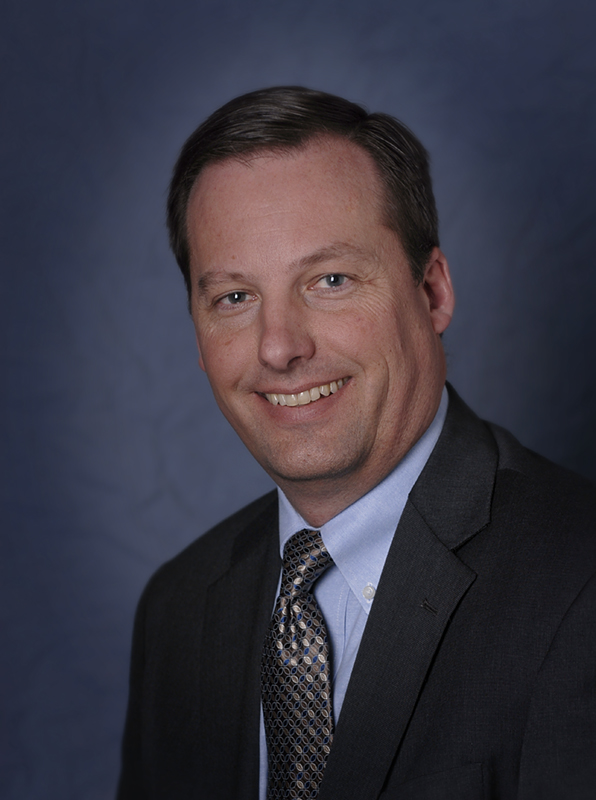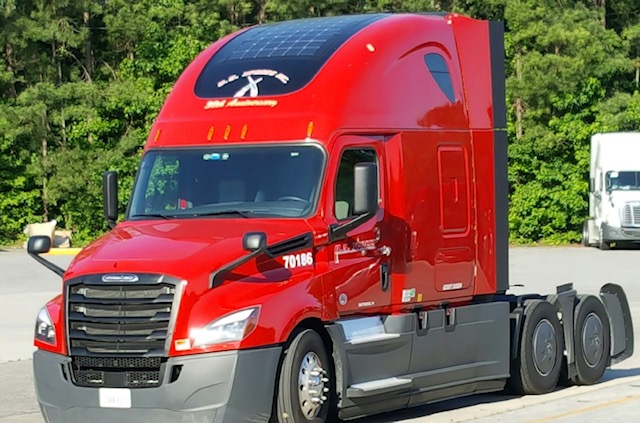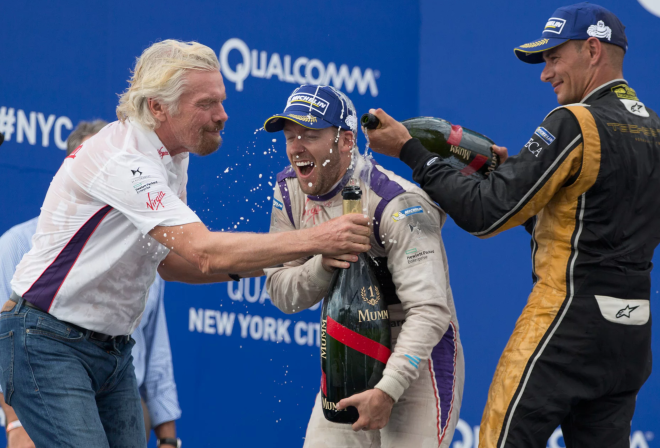In the four year-plus existence of GreenSportsBlog, we’ve reported on a wide variety of sports, from surfing to auto racing, from cricket to disk sports. Well, today we take a bit of poetic license as we take a look at long haul trucking. The first ever Run on Less (ROL) fuel-economy roadshow kicked of on September 6 and extends until September 26-28. ROL is not a race — thus, the poetic license — but it puts seasoned drivers and trucks to the test as they haul freight over three weeks from various starting points in the US and Canada to Atlanta in trucks equipped with a variety of technologies that improve fuel efficiency.
The North American Council for Freight Efficiency (NACFE) and nonprofit Carbon War Room, founded by Sir Richard Branson, are the driving forces behind Run on Less (ROL), the first-of-its-kind fuel-economy roadshow that kicked off September 6. Seven seasoned drivers, working for PepsiCo’s Frito-Lay division as well as companies that are well-known in the trucking industry^, were selected to haul freight in trucks equipped with a variety of technologies that improve fuel efficiency from a variety of starting points to Atlanta.
When I first read about Run On Less, I thought to myself, “This is a cool and important story but it’s not technically a sport since the drivers aren’t racing. I understand why — minimizing crashes with trucks full of freight is a laudable idea —and it’s impossible, since they’re starting from different points across the US and Canada, to equalize for truck makes, loads, terrains, winds and more. Thus the goal isn’t to get to Atlanta first.” But I still thought it would be an interesting story for you, the readers, so I decided to call Mike Roeth, Executive Director of NACFE, to see if there was a sports hook, a sports analogy, to which I could latch on.

Mike Roeth, Executive Director of NACFE (Photo credit: NACFE)
Mike found one: NBA All Star Weekend.
“Look at ‘Run on Less’ as if it’s a skills competition like the NBA Slam Dunk or Three Point Shooting Contest of trucking,” recommended Mr. Roeth. “We designed it to showcase efficient and effective driving skills, rather than go for a championship of some kind.”
Works for me!
So here’s the gist:
The seven trucks (two Volvos, two Internationals and 3 Cascadias), all less than three years old, are outfitted with a wide array of advanced fuel efficiency technologies. As no two trucks are the same, each fleet selects its own combination of technologies to achieve its fuel-efficiency goals. According to Mr. Roeth, “The trucks have different aerodynamics technologies: Some feature low rolling resistance tires, others have automatic tire inflation. There will be a variety of state-of-the-art power trains and automated manual transmissions. Several of the trucks are equipped with 15-liter engines, and others are going smaller, with a 13-liter and an 11-liter engine among the group. Three of the trucks have solar panels to generate power while the drivers are sleeping.”

Truck cab with solar panels on the roof. Three of the trucks in Run On Less have on board solar. (Photo credit: USXpress)
The trucks will, when it’s all said and done, have driven a combined 40,000 miles over roughly two and a half weeks. The routes and the types of driving will vary greatly: One fleet is delivering auto parts from El Paso, Texas, to Ellisville, Missouri. Another is making dedicated store deliveries in Illinois, Indiana, Michigan, Ohio, and Kentucky. Yet another is running a route from Laredo, Texas, to the Carolinas. And another is doing daily round-trips from Perry, Georgia, to Charleston, South Carolina.
Weather has played a major role in Run On Less. “Hurricanes Harvey and Irma had a significant effect,” said Roeth, at a New York City press conference on Tuesday, heralding Run On Less. “Routes had to change, fuel availability became an issue and winds at times hindered and at other times helped the drivers.”
No matter the route and the load, data is being collected on board in real time, courtesy of GPS technology partner Geotab, and is being updated 6-8 times per day on the Run On Less website. “We track dollars, gallons and CO₂ emissions saved,” reported Mr. Roeth. “Every gallon of diesel not burned saves 22 lbs. of CO₂. Over the first 10 days of the run, the drivers averaged 10.1 miles per gallon (mpg), economy that’s 57 percent better than the national average of 6.4 mpg for trucks in this size range#. Perhaps the greatest thing is that the technologies being used are order-able right now, available to anyone.”
According to NACFE, if the 1.7 million trucks on the road in the US and Canada today achieved the same level of efficiency as the trucks in Run On Less, there would be annual cumulative savings of 98 million tons of CO₂ and $48 billion. The market opportunity for efficient technologies in trucking is massive because, per Mr. Roeth, only “about 100,000 trucks are outfitted with the advanced efficiency technologies.”
That said, the trucking industry has come a long way on environmental issue over the last three decades or so. “Going back to 1990, the EPA put environmental restrictions on NOx — a generic term for the nitrogen oxides that are most relevant for air pollution, namely nitric oxide (NO) and nitrogen dioxide (NO₂) — so trucks would run cleaner,” offered Mr. Roeth. “The industry didn’t like it because it cost more and resulted, counterintuitively, in slightly lower miles per gallon performance. Fast forward to the present. Now with efficiency being the main the goal of most EPA regulations, the industry has gotten behind them. You can understand why when fuel costs nowadays run to $40,000 per year. And when gas is $4 a gallon, those annual fuel costs can spike to upwards of $70,000.”
On climate change, Mr. Roeth asserts that the industry and their large customers “get it — for the most part. This is true especially for companies like Pepsi, Amazon and Wal-Mart, for which sustainability is a big deal. On the other hand, some in the industry prefer to stay away from climate change and stick with energy efficiency. Drivers of course like the increased fuel economy — in addition to the obvious reasons of saving money and cleaner air, one driver told me ‘I like it because it means I have to stop less frequently’.”
As for electrification of the long haul trucking fleet, Mr. Roeth sees the industry moving slowly — or maybe not: “It will take awhile to get to scale on electrification for trucks — it will happen more quickly with passenger cars. Right now, it simply is easier to add size to a gas tank to give a truck more range than it is to get similar range with batteries. But I may be proven wrong as battery technology is improving — and the costs are decreasing — exponentially. I’ll be happy if that’s the case.”
Finally, at Tuesday’s presser, it fell to Sir Richard Branson to bring home the power of Run On Less in a very personal way: “After spending the last week or so in the British Virgin Islands, which got absolutely leveled by Hurricane Irma — in the immediate aftermath it looked like an atom bomb had hit — it’s strange to be here talking about trucking…But, actually, Run On Less offers a ray of hope as it is showing the amount of carbon that can be saved by the industry [if it simply adopts already available technologies] is gigantic.”

Sir Richard Branson (l) at the NACFE press conference (Photo credit: Lewis Blaustein)
^ Albert Transport, Hirschbach, Mesilla Valley Transportation, Nussbaum Transportation, Ploger Transportation, and US Xpress are the other trucking companies taking part
# Trucks get far lower fuel economy than even SUVs, much less sedans or subcompact cars. This should not be surprising as these are extremely heavy vehicles carrying staggeringly heavy loads.
Please comment below!
Email us: lew@greensportsblog.com
Friend us on Facebook: http://facebook.com/greensportsblog
Tweet us @GreenSportsBlog


